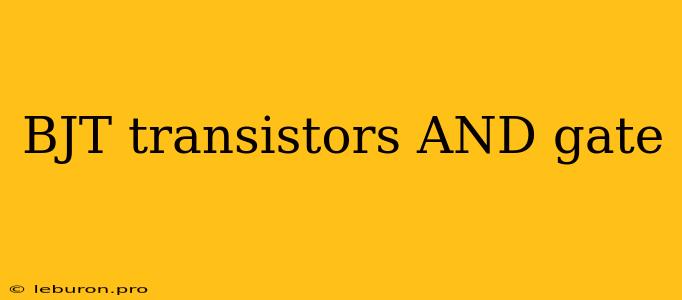Understanding the Logic of BJT Transistors: Implementing an AND Gate
The world of digital electronics is built upon a foundation of logic gates, fundamental building blocks that perform specific operations on binary inputs. One of the most common and essential logic gates is the AND gate, which outputs a "1" only when all its inputs are "1." This seemingly simple concept is brought to life through various electronic implementations, with BJT transistors playing a crucial role. This article delves into the intricacies of using BJT transistors to construct a functional AND gate.
The Fundamentals: BJT Transistors and Logic Gates
BJT transistors, short for Bipolar Junction Transistors, are semiconductor devices that act as electronic switches, controlling the flow of current in a circuit. Their ability to amplify signals and operate as controlled switches makes them ideal for implementing logic gates.
An AND gate takes two or more inputs and produces an output that is "1" only when all the inputs are "1". In a logic circuit, "1" typically represents a high voltage level, while "0" represents a low voltage level.
The BJT-based AND Gate: A Practical Implementation
To construct an AND gate using BJT transistors, we utilize the transistor's ability to act as a switch, controlled by its base current. Let's consider a simple circuit with two BJT transistors, Q1 and Q2, acting as the inputs, and a single output.
Circuit Explanation:
- Inputs (A and B): The inputs A and B are connected to the bases of Q1 and Q2 respectively.
- Base Resistors (R1 and R2): Resistors R1 and R2 limit the base current of each transistor.
- Collector Resistor (Rc): The collector resistor Rc is connected to the collector of Q2 and sets the output voltage level.
- Output (Y): The output Y is taken from the collector of Q2.
Operation of the BJT-based AND Gate:
-
Input "0" (Low Voltage): When either input A or B is at a low voltage (0), the corresponding transistor (Q1 or Q2) is turned off. This means the base current is insufficient to turn the transistor on, and the collector current remains low.
-
Input "1" (High Voltage): When both inputs A and B are at a high voltage (1), both transistors Q1 and Q2 are turned on. The base current of each transistor is sufficient to allow a significant collector current to flow.
-
Output "0": If either input A or B is low, the collector current of Q2 remains low, resulting in a low output (0) at Y.
-
Output "1": Only when both inputs A and B are high, does the collector current of Q2 flow freely, resulting in a high output (1) at Y.
Important Notes:
-
The voltage levels for "0" and "1" are dependent on the specific circuit and transistor characteristics.
-
The resistors (R1, R2, and Rc) are chosen to ensure proper operation and to avoid excessive current flow.
Advantages and Disadvantages of BJT-based AND Gates
Advantages:
- Simple Implementation: The basic circuit using two BJT transistors is relatively simple to understand and build.
- Relatively Low Cost: The BJT transistors used are generally inexpensive.
- Good Performance: These gates can achieve reasonable switching speeds and voltage levels.
Disadvantages:
- Limited Number of Inputs: It's more challenging to implement AND gates with many inputs using the basic BJT transistor configuration.
- Limited Noise Immunity: The circuit can be susceptible to noise and variations in input voltage levels.
- Power Consumption: BJT transistors can have a moderate power consumption.
Beyond the Basics: Implementing Complex Logic Functions
The basic BJT transistor configuration for an AND gate can be extended to implement more complex logic functions. By combining multiple AND gates with other logic gates like OR gates, NOT gates, and XOR gates, it's possible to create circuits that can perform complex Boolean operations.
The Future of Logic Gates: Beyond BJT Transistors
While BJT transistors have served as the workhorses of digital electronics for decades, advancements in semiconductor technology have led to the development of other types of transistors, such as MOSFETs, offering greater advantages in terms of size, power consumption, and speed. MOSFET-based logic gates have become increasingly popular in modern digital circuits.
Conclusion
The BJT transistor plays a fundamental role in implementing digital logic, providing a simple and practical approach to building AND gates. Understanding the operation of BJT transistor-based AND gates provides a crucial foundation for comprehending the workings of digital circuits. While modern digital circuits increasingly rely on MOSFETs, the understanding of BJT transistor logic remains vital for understanding the history and evolution of digital electronics. The versatility and adaptability of BJT transistors continue to make them valuable in various applications, from basic logic circuits to more complex analog designs.
